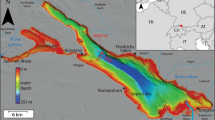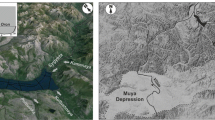Abstract
Lake Winnipeg, the seventh largest lake in North America, is located at the boundary between the Interior Plains and the Canadian Shield in Manitoba, Canada. Seismic profiles were obtained in Lake Winnipeg on two geoscientific cruises in 1994 and 1996. These data indicate the morphology of the bedrock surface. In most cases, a clear distinction between low relief Paleozoic carbonate rock and high relief Precambrian rock can be made. In northern Lake Winnipeg, the eastern limit of Paleozoic rock is clearly demarcated 30 km west of the previous estimate of its position. In southern Lake Winnipeg, all or most of the Paleozoic sequence terminates at a prominent buried escarpment in the centre of the lake. This indicates that Paleozoic rock on the eastern shore, known from drilling and outcrops, is an outlier. Major moraines are apparent as abrupt, large ridges having a chaotic internal reflection pattern. These include the Pearson Reef Moraine, the George Island Moraine and the offshore extension of The Pas Moraine. Little evidence for extensive or thick till was observed. Instead, fine-grained sediments deposited in glacial Lake Agassiz rest directly on bedrock over most of the lake basin. Hence an episode of erosion to bedrock was associated with glaciation and/or deglaciation. The Agassiz Sequence sediments are well-stratified, drape underlying relief and in some areas are over 100 m thick. In places, stratification in these sediments is disrupted, perhaps by dewatering. Evidence of erosion of Agassiz Sequence sediments by recent currents was observed. The contact between the Agassiz Sequence and the overlying Winnipeg Sequence sediments is a marked angular unconformity. The Agassiz Unconformity indicates up to 10 m of erosion in places. The low-relief character of this unconformity precludes subaerial erosion and the lack of till, moraines, or extensive deformation precludes glacial erosion. Waves appear to be the most likely erosional agent, either in waning Lake Agassiz or early Lake Winnipeg time. Winnipeg Sequence sediments, in places very thin, mantle most of the lakefloor. These sediments were deposited in the present Lake Winnipeg and are faintly stratified to massive and reach about 10 m in thickness in deep water. On the surface of the Winnipeg Sequence, vigorous, episodic currents are thought to contribute to the construction of flow-transverse sand waves as much as 6 m high in a deep, narrow constriction in the lake.
Similar content being viewed by others
References
Amos, C. L. & E. L. King, 1984. Bedforms of the Canadian eastern seaboard: a comparison with global occurrences. Mar. Geol. 57: 167–208.
Bajkov, A., 1930. Biological conditions of Manitoban lakes. Contributions to Canadian Biology and Fisheries, 5: 383–422.
Bell, C. K., 1978. Geology, Wekusko Lake map area. Geol. Surv. Can., Memoir 384, 84 pp.
Betcher, R. N., 1986. Groundwater availability map series, Selkirk area (62I). Manitoba Water Resources Branch.
Betcher, R. N. & W. M. Buhayf, 1996. Pore-water chemistry of Lake Winnipeg sediments. In Todd, B. J., C. F. M. Lewis, L. H. Thorleifson & E. Nielsen (eds), Lake Winnipeg Project: cruise reports and scientific results, Geological Survey of Canada Open File Report 3113: 241–252.
Bezys, R. K., 1996a. Paleozoic geology of the Lake Winnipeg area and repositioning of the PrecambrianPaleozoic boundary. In Todd, B. J., C. F. M. Lewis, L. H. Thorleifson & E. Nielsen (eds), Lake Winnipeg Project: cruise reports and scientific results, Geological Survey of Canada Open File Report 3113: 127–139.
Bezys, R. K., 1996b. Sub-Paleozoic structure in Manitoba's northern Interlake along the Churchill Superior Boundary Zone: A detailed investigation of the Falconbridge William Lake study area. Manitoba Energy and Mines, Minerals Division, Open File Report OF943, 32 pp.
Bezys, R. K. & H. R. McCabe, 1996. Lower to Middle Paleozoic stratigraphy of southwestern Manitoba - field trip guidebook B4. Geological Association of Canada - Mineralogical Association of Canada Joint Annual Meeting, Winnipeg, Manitoba: 92 pp.
Brunskill, G. J. & B. W. Graham, 1979. The offshore sediments of Lake Winnipeg. Canadian Fisheries and Marine Service Manuscript Report No. 1540, 75 pp.
Canadian Hydrographic Service, 1981. Observation Point to Grindstone Point, Chart 6248. Scale 1:48 000.
Canadian Hydrographic Service, 1982. Berens River to Nelson River, Chart 6241. Scale 1:255 723.
Canadian Hydrographic Service, 1986. Red River to Gull Harbour, Chart 6251. Scale 1:100 000.
Dowling, D. B., 1900. Report on the geology of the west shore and islands of Lake Winnipeg. Geological Survey of Canada Annual Report for 1898, v. 11, Part F, 98 pp.
Gerhard, L. E., S. B. Anderson & D. W. Fisher, 1990. Petroleum geology of theWilliston Basin. In Leighton, M.W., D. R. Kolata, D. F. Oltz & J. J. Eidel (eds), Interior Cratonic Basin, Am. Assoc. Petrol. Geo., Memoir 51: 507–559.
Grice, R. H., 1970. Quaternary geology of the Grand Rapids area. Can. J. Earth Sci. 7: 853–857.
Groom, H. D., 1985. Surficial geology and aggregate resources of the Fisher Branch area, Local Government District of Fisher and Rural Municipality of Bifrost. Manitoba Energy and Mines, Mineral Resources Division, Aggregate Report 842, 33 pp.
Hovland, M. & A. G. Judd, 1988. Seabed pockmarks and seepages. Graham and Trotman Inc., Sterling House, London: 293 pp.
Kenney, B. C., 1979. Lake surface fluctuations and the mass flow through The Narrows of Lake Winnipeg. J. Geophys. Res. 84: 1225–1235.
Klassen, R. W., 1967. Surficial geology of the Waterhen-Grand Rapids area, Manitoba. Geological Survey of Canada Paper 6636, 6 pp.
Kushnir, D. W., 1971. Sediments in the South Basin of Lake Winnipeg. Unpublished M.Sc. thesis, University of Manitoba, Winnipeg: 92 pp.
Lebedin, J., 1978. Groundwater resources of the Beausejour area. Canada Department of Regional Economic Expansion, Prairie Farm Rehabilitation Administration, Engineering Services, Regina.
Lewis, C. F. M. & B. J. Todd, 1996. Lithology and seismostratigraphy of long cores, and a reconstruction of Lake Winnipeg water level history. In Todd, B. J., C. F. M. Lewis, L. H. Thorleifson & E. Nielsen (eds), Lake Winnipeg Project: cruise reports and scientific results, Geological Survey of Canada Open File Report 3113: 161–192.
Manitoba Mineral Resources Division, 1979. Geological map of Manitoba, Map 792, scale 1:1 000 000.
Matile, G. L. D. & H. D. Groom, 1987. Late Wisconsinan stratigraphy and sand and gravel resources in the Rural Municipality of Lac du Bonnet and Local Government District of Alexander. Manitoba Energy and Mines, Mines Branch, Aggregate Report AR 852, 44 pp.
McCabe, H. R., 1983. GS22 stratigraphic mapping and stratigraphic and industrial minerals corehole program. Manitoba Energy and Mines, Mineral Resources Division, Report of field activities, 1983: 122–130.
McKinnon, N. T., 1996. Mapping of lakefloor features in Lake Winnipeg ausing sidescan sonar and high resolution seismic reflection. Unpublished B.Sc. Thesis, Carleton University, Ottawa, Ontario: 41 pp.
Mitchum, R.M. Jr., P. R. Vail & J. B. Sangree, 1977. Seismic stratigraphy and global changes of sea level, part 6: stratigraphic interpretation of seismic reflection patterns in depositional sequences. In Payton, C. E. (ed.), Seismic stratigraphy - applications to hydrocarbon exploration, Am. Assoc. Petrol. Geol., Memoir 26, Tulsa: 117–133.
Mitchum, R. M. Jr., P. R. Vail & S. Thompson III., 1977. Seismic stratigraphy and global changes of sea level, part 2: the depositional sequence as a basic unit for stratigraphic analysis. In Payton, C. E. (ed.), Seismic stratigraphy - applications to hydrocarbon exploration, Am. Assoc. Petrol. Geol., Memoir 26, Tulsa: 53–62.
Nielsen, E., 1989. Quaternary stratigraphy and overburden geochemistry in the Phanerozoic terrane of southern Manitoba. Manitoba Energy and Mines, Geological Paper GP 871, 78 pp.
Nielsen, E. & L. H. Thorleifson, 1996. Quaternary geology of the Lake Winnipeg area. In Todd, B. J., C. F. M. Lewis, L. H. Thorleifson & E. Nielsen (eds), Lake Winnipeg Project: cruise reports and scientific results, Geological Survey of Canada Open File Report 3113: 141–157.
Norford, B. S., F. M. Haidl, R. K. Bezys, M. P. Cecile, H. R. McCabe & D. F. Paterson, 1994. Middle Ordovician to Lower Devonian strata of the Western Canada Sedimentary Basin. In Mossop, G. D. & I. Shetsen (compilers), Geological atlas of the Western Canada Sedimentary Basin, Calgary, Can. Soc. Petrol. Geol. and Alberta Res. Council, 109–127.
Render, F. W., 1970. Geohydrology of the metropolitan Winnipeg area as related to groundwater supply construction. Can. Geotechn. J. 7: 243–274.
Simpkin, P. G. & A. Davis, 1993. For seismic profiling in very shallow water, a novel receiver. Sea Technol. 34: 22–28.
Sheriff, R. E. & L. P. Geldart, 1982. Exploration seismology, Vol. 1, History, theory, and data acquisition. Cambridge University Press, 253 pp.
Tarnocai, C., 1970. Glacial history, surface deposits, soils and vegetation of Wekusko and portions of Cross Lake, Norway House and Grand Rapids map area, Manitoba. Fourteenth Manitoba Soil Science Meeting, 22–25.
Teller, J. T. & L. Clayton, 1983. An introduction to glacial Lake Agassiz. In Teller, J. T. & L. Clayton (eds), Glacial Lake Agassiz, Geological Association of Canada Special Paper 26: 3–5.
Todd, B. J., 1996. Cruise report of the 1994 Lake Winnipeg Project: Namao 94900. In Todd, B. J., C. F. M. Lewis, L. H. Thorleifson & E. Nielsen (eds), Lake Winnipeg Project: cruise reports and scientific results, Geological Survey of Canada Open File Report 3113: 9–75.
Todd, B. J., in prep. Cruise report of the 1996 Lake Winnipeg Project: Namao 96900. In Todd, B. J., C. F. M. Lewis, D. L. Forbes, L. H. Thorleifson & E. Nielsen (eds.), Lake Winnipeg Project, Phase II: cruise reports and preliminary scientific results, Geological Survey of Canada Open File Report.
Todd, B. J. & C. F. M. Lewis, 1993. A reconnaissance geophysical survey of the Kawartha Lakes and Lake Simcoe, Ontario. Géeographie physique et Quaternaire 7: 313–323.
Todd, B. J. & C. F. M. Lewis, 1996. Seismostratigraphy of Lake Winnipeg sediments. In Todd, B. J., C. F. M. Lewis, L. H. Thorleifson & E. Nielsen (eds), Lake Winnipeg Project: cruise reports and scientific results, Geological Survey of Canada Open File Report 3113: 79–117.
Tyrell, J. B. & D. B. Dowling, 1900. Report on the east shore of Lake Winnipeg and adjacent parts of Manitoba and Keewatin. Geological Survey of Canada Annual Report for 1898, v. 11, Part G, 98 pp.
Upham, W., 1890. Report on exploration of the Glacial Lake Agassiz in Manitoba. Geological Survey of Canada Annual Report for 1888-1889, v. 5, Section E, 156 pp.
Ward, G., 1926. Seasonal variation in the composition of the Red River. Unpublished M.Sc. thesis, University of Manitoba, Winnipeg: 24 pp.
Author information
Authors and Affiliations
Rights and permissions
About this article
Cite this article
Todd, B.J., Lewis, C.F.M., Nielsen, E. et al. Lake Winnipeg: geological setting and sediment seismostratigraphy. Journal of Paleolimnology 19, 215–243 (1998). https://doi.org/10.1023/A:1007997024412
Issue Date:
DOI: https://doi.org/10.1023/A:1007997024412




